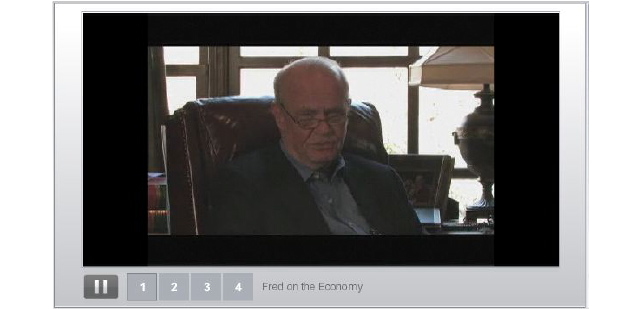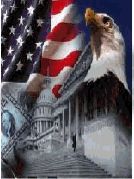
News
Behind the Headlines
Two-Cents Worth
Video of the Week
News Blurbs
Articles
Testimony
Bible Questions
Internet Articles (2015)
Internet Articles (2014)
Internet
Articles (2013)
Internet Articles (2012)
Internet Articles (2011)
Internet Articles (2010)
Internet Articles
(2009)
Internet Articles (2008)
Internet Articles (2007)
Internet Articles (2006)
Internet Articles (2005)
Internet Articles (2004)
Internet Articles (2003)
Internet Articles (2002)
Internet Articles (2001)

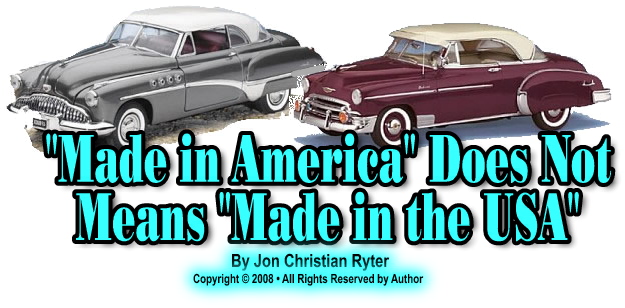
 he
heads of the Big-Three automakers were back in Washington, DC last week,
hats in hand, wearing virtual knee pads designed for groveling before
Congress. When they arrived this time, the corporate jets owned by General
Motors, Ford and Chrysler—which had caused them a firestorm of criticism
on their first visit to DC—were parked on the tarmack. In
fact, those luxury jets that ferried auto industry executives around the
world had joined the corporate jets owned by Citicorp and AT&T on
the auction block after the media slammed them for flying to Washington
in luxury jets to plead for money. After failing to secure their bailout
a week ago, both GM and Ford said they would sell their corporate jets.
he
heads of the Big-Three automakers were back in Washington, DC last week,
hats in hand, wearing virtual knee pads designed for groveling before
Congress. When they arrived this time, the corporate jets owned by General
Motors, Ford and Chrysler—which had caused them a firestorm of criticism
on their first visit to DC—were parked on the tarmack. In
fact, those luxury jets that ferried auto industry executives around the
world had joined the corporate jets owned by Citicorp and AT&T on
the auction block after the media slammed them for flying to Washington
in luxury jets to plead for money. After failing to secure their bailout
a week ago, both GM and Ford said they would sell their corporate jets.
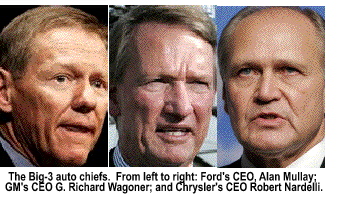 Chrysler,
which is far more cosmopolitan than their "domestic" Motor City
competitors, was shamed into joining them.
Chrysler,
which is far more cosmopolitan than their "domestic" Motor City
competitors, was shamed into joining them.
On their second begging-go-round,
instead of arriving in the lap of "corporate luxury" (which
each Big-3 CEO enjoys in his multimillionaire lifestyle), they drove to
DC in their company's latest hybrid vehicle specifically designed to win
the hearts of the watermelons the nation's capital.  (A
watermelon is a liberal politician who is green on the outside
and communist red on the inside. Green is the new "red." Yesterday's
socialists are today's environmentalists. Green is the anti-capitalist,
antihuman agenda of the Vietnam Era far left that once again controls
Congress and, will also control the White House on January 20, 2009.)
(A
watermelon is a liberal politician who is green on the outside
and communist red on the inside. Green is the new "red." Yesterday's
socialists are today's environmentalists. Green is the anti-capitalist,
antihuman agenda of the Vietnam Era far left that once again controls
Congress and, will also control the White House on January 20, 2009.)
To impress and also to intimidate the Democratic leadership on this visit, the Big-3 heads brought United Auto Workers President Ron Gettelfinger to argue that the 73 thousand rank and file UAW workers in the United States needed the bailout to keep their jobs. The bailout requested by the Big-3 would be equal to about $3,500.00 per UAW worker—many of whom, according to GM-Brazil President Jaime Ardila, will be laid off when GM gets the funds it needs from the taxpayers of the United States. When Ardila was interviewed by the Brazilian newspaper, Gazeta Mercantil, the reporter said that statements made by GM, Chrysler and Ford to Congress suggested that, without the bailout, the Big-3 would go bankrupt and, with it, all the Big-3 would be able to do is shore of their US operations. Ardila said: "It wouldn't be logical to withdraw the investments from [the emerging nations] where [GM] is growing, and our goal is to protect investments in emerging markets."
According to news reports in the Argentina Star, the increased investment by GM in South America will coincide with more plant closings in the United States. Any Congressman and/or Senator worth his/her salt has been researching the development of new Ford, Chrysler and GM plants in the emerging economies and is very much aware that the taxpayer dollars requested by the Big-3 will be used by GM, Ford and Chrysler to build or refurbish their auto assembly plants in the emerging economies around the world; and that the US-brand auto manufacturers, using tax dollars squeezed from the sweat equity of US workers.
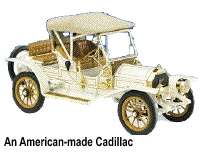 Ironically,
at the end of the day on Friday, Dec. 5, the Democratic majority, swayed
by Labor Dept. report of the loss of 533 thousand US jobs in November,
settled on a $15 billion rescue package for the Big-3 (or roughly $2,100.00
for each US auto worker) instead of the $34 billion the Big-3 sought.
The New York Times reported on Sat., Dec. 6 that Democrats were
likely to come up with $25 billion in federally subsidized loans to the
help the Big-3, but the money would be specifically earmarked for the
development of fuel-efficient cars.
Ironically,
at the end of the day on Friday, Dec. 5, the Democratic majority, swayed
by Labor Dept. report of the loss of 533 thousand US jobs in November,
settled on a $15 billion rescue package for the Big-3 (or roughly $2,100.00
for each US auto worker) instead of the $34 billion the Big-3 sought.
The New York Times reported on Sat., Dec. 6 that Democrats were
likely to come up with $25 billion in federally subsidized loans to the
help the Big-3, but the money would be specifically earmarked for the
development of fuel-efficient cars. 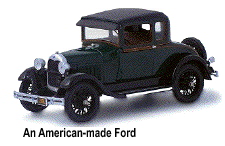 With
gasoline prices now under $2.00 per gallon once again, US consumers simply
aren't interested in small, four passenger hybrid cars that burn $3 per
gallon biofuels, or highway versions of electric golf carts. What US consumers
want is for Congress to get out of the way of the free enterprise system,
uncap the oil reserves in the United States and give independent oil drillers
and independent oil refiners the right to compete in the oil industry.
This will drive down the price of oil in the United States.
With
gasoline prices now under $2.00 per gallon once again, US consumers simply
aren't interested in small, four passenger hybrid cars that burn $3 per
gallon biofuels, or highway versions of electric golf carts. What US consumers
want is for Congress to get out of the way of the free enterprise system,
uncap the oil reserves in the United States and give independent oil drillers
and independent oil refiners the right to compete in the oil industry.
This will drive down the price of oil in the United States.
While Bush Chief of Staff Josh Bolton worked closely with House Speaker Nancy Pelosi [D-CA] to find a way around the impasse—i.e., where the money comes from—the liberals in Congress resisted the notion advanced by the White House that the bailout money come from the $25 billion provided in the Auto Industry Emergency Bridge Loan Act that was enacted on Nov. 21, 2008 after the Big-3's first congressional "beg-fest." Congress wanted to dip into the $700 billion slush fund set up to bail out the mortgage industry and jumpstart the stalled availability of consumer credit by infusing local banks with loan liquidity to help consumers with credit scores that are less than perfect. Bush warned he would not sign that bill into law, causing the Friday impasse.
House Financial Services
Committee Chairman Barney Frank [D-MA] and ranking Republican
Spencer Bachus [R-AL] argued that the failure of the US auto industry
could have even worse consequences on the already teetering US economy.
Bachus has visions of a 1929-type market collapse. Frank
urged Pelosi to find a compromise with the White House, arguing
that sending the auto executives home empty-handed would deliver a blow
to the economy that would send it into an even deeper tailspin. 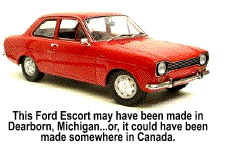 At
the end of the six hour hearing with the Big-3, Frank noted that
the measure was so politically unpopular with the American people that
"...if we're lucky, we'll come out with a bill that nobody likes
[since that's the only bill that will have a chance of passing."
At
the end of the six hour hearing with the Big-3, Frank noted that
the measure was so politically unpopular with the American people that
"...if we're lucky, we'll come out with a bill that nobody likes
[since that's the only bill that will have a chance of passing."
Pelosi and Senate Banking Committee Chairman Christopher Dodd [D-CT] pushed Bush to tap into the $700 billion Wall Street bailout money to provide the $34 billion the auto industry said its needs to stave off bankruptcy. Bush insisted on using $15 billion of the $25 billion Dept. of Energy green car program money. Those dollars will be spent making US-branded "green" cars in South America, Mexico, Canada, Germany, Russia, China and the Union of South Africa that will, in reality, still burn fossil fuels mixed with bio-fuels made from cereal grains that will escalate the price of Cheerios, Wheaties, Shredded Wheat and Corn Flakes faster than the shrinking value of our already too elastic, fiat dollar. Or, bio-fuels made from sugar cane that will escalate the price of your kid's Sugar Pops and Sugar Frosted Flakes even faster. And, believe me, Tony The Tiger won't think "that's g-gr-great!"
Two things makes this bailout unpalatable to the America people. First, there's something inherently wrong when billion dollar transnational corporations—and the Congressmen and Senators in their hip pockets—expect working class US taxpayers to bail them out when they make bad marketing decisions (like putting all of their eggs in gas guzzling monster trucks and oversized SUV basket when the price of gasoline is skyrocketing and consumers are only buying fuel-efficient vehicles). Particularly when Congress was never given the right by the Constitution to raid the pockets of the taxpayers to benefit their donor constituents, the "commerce clause" notwithstanding. (Until liberals in Lyndon Johnson's Great Society discovered the commerce clause, the phrase "promote the general welfare" in the Preamble of the Constitution was just a declaratory statement that explained the intent of the document.) There are no implied rights in the Preamble. Social justice liberals, backed by far left federal judges who believe the Constitution periodically needs to be reinterpreted to fit the evolving needs of society, redefined the Preamble as an implied right of government although the authority and responsibilities of each of the branches of government are defined in Articles I, II and III—only.
Second, is the fear of a majority of Americans—i.e., US citizens—that since the enactment of NAFTA, Ford, GM, and Chrysler, who still profess to be US companies only because they must rely on US sales until their new workers in the emerging economies can afford the widgets and whatnots manufactured by the former US industrialists who now call the human-capital rich nations of Mexico, China, India, Brazil, and Indonesia "home," will spend the bailout money given to them by the US Congress not to develop new jobs in the United States but, rather, in Mexico, China, India, Brazil, Indonesia and Europe.
When GM CEO Rick Wagoner, Ford CEO Alan Mullaly, and Chrysler CEO Robert Nardelli came to Washington for "Bailout, Part One" they had already committed billions of dollars to plant construction and modernization around the world. GM has committed $1 billion to the renovation of its assembly plant in San Paulo, Brazil. Also, GM committed $250 million to an engine and small parts plant. In addition, GM is spending another $600 million for a Chevrolet production plant in Santa Catarina, and $150 million for a parts plant in Sao Paulo. Also, GM has committed $500 million to renovate its GM-Opel plant in Hesse (Germany), $300 million to a state-of-the-art assembly line plant in Russia, and $1 billion each for plants in India and China.
GM, Ford and Chrysler, which were upsizing their vehicles when the rest of the world was downsizing, are losing the war for the driveway. The combined penetration in the US market by Big-3 branded vehicles is now 47%. In 2007, it was 51%. GM global sales dropped 28% this year. Ford's sales skidded 33% and Chrysler's sales nosedived 42%. In 2006 there were 7.6 million motor vehicles sold in the United States. Of those, 5.5 million (including Ford, GM and Chrysler), were imported under NAFTA guidelines from manufacturing plants in other nations. What that means is that only 2.1 million of the vehicles purchased by US consumers in 2006 were actually made in the United States by US labor. And, about 75% of the American built cars were made by Toyota, Honda, or Hyundai. Only about 520,500 of the GM-, Ford- or Chrysler-branded vehicles sold in the US in 2006 were made in the US by US workers, meaning the majority of the remaining 1,579,500 US-built vehicles were made by Toyota, Honda or Hyundai.
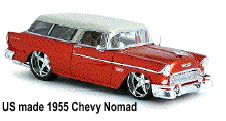 That,
of course, is the reason GM said it would be forced to layoff another
5,500 US autoworkers if the bailout didn't materialize. But, according
to both the Argentina Star and Gazeta Mercantil in San Paulo,
Brazil, when the bailout was finalized the US layoffs were going to take
place since GM would now use its money to protect its investments in the
emerging markets.
That,
of course, is the reason GM said it would be forced to layoff another
5,500 US autoworkers if the bailout didn't materialize. But, according
to both the Argentina Star and Gazeta Mercantil in San Paulo,
Brazil, when the bailout was finalized the US layoffs were going to take
place since GM would now use its money to protect its investments in the
emerging markets.
In 2006, GM embarked on a
national advertising campaign designed to erode the sale of American made
Toyotas, Hondas and Hyundai cars and trucks by touting their cars and
trucks as "American made."  Their
national ads asked the question: "Do American car companies
know what Americans want?" They answered their own question
by saying: "Our cars and trucks stand up to anyone's—foreign
or domestic. That's the focus. And that's the mission. All the global
car company that's proud to be American."
Their
national ads asked the question: "Do American car companies
know what Americans want?" They answered their own question
by saying: "Our cars and trucks stand up to anyone's—foreign
or domestic. That's the focus. And that's the mission. All the global
car company that's proud to be American."
The American consumers GM
was talking about—the people GM expected to buy their vehicles—were
US citizens. But the "Americans" who were to make the "American"
cars they expect US citizens to buy were "Americans" only in
the sense of geography. Some of them live in North America. Some of them
live in Central America. 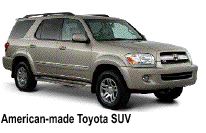 And
some of them live in South America. But only those who live in the United
States actually refer to themselves as Americans. Canadians refer to themselves
as Canadians. Mexicans would rather poke themselves in the eye with the
dirty stick than be called Americans. And, to those who live in the 13
South American nations, being called an "American" is a epithet
usually aimed at US tourists but is primarily reserved for US corporations
in the international arena.
And
some of them live in South America. But only those who live in the United
States actually refer to themselves as Americans. Canadians refer to themselves
as Canadians. Mexicans would rather poke themselves in the eye with the
dirty stick than be called Americans. And, to those who live in the 13
South American nations, being called an "American" is a epithet
usually aimed at US tourists but is primarily reserved for US corporations
in the international arena.
When it comes to cars, what
do Americans—US citizens—want? It's simple. They want cars made
in America, or more specifically, cars made in the United States. Not
Canada. Not Mexico. Not Brazil. And certainly not US branded cars from
Germany, Indonesia, India or the Union of South Africa. Or more than anything
else, they don't want US branded cars that are made in China and smuggled
back into the United States through NAFTA's tariff-free swinging doors
on the US/Mexico border. In the minds of the American people, "made
in America" means "made in the United States of America."
Anything else is false advertising. 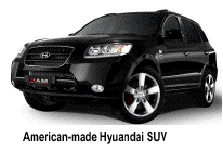 It
is fraud committed against the people of the United States by the transnational
industrialists who owe no allegiance or fidelity to the United States,
and view themselves as multinational corporations even though they were
American born through the sweat equity of US workers.
It
is fraud committed against the people of the United States by the transnational
industrialists who owe no allegiance or fidelity to the United States,
and view themselves as multinational corporations even though they were
American born through the sweat equity of US workers.
At the end of World War II, Democratic President Harry S. Truman agreed to open the US economy to its former allies—and enemies. The globalists who needed to rebuild the economies of war-torn Europe and Asia believed the US economy was strong enough to open their doors to billions of dollars of tariff-free goods from all over the world without reciprocal trade agreements from those nations that required them to open their doors to export from US manufacturers. Truman signed the UN's General Agreement on Tariffs and Trade on Oct. 23, 1947. GATT went into affect on January 1, 1948, starting the slow motion domino affect that ultimately led to NAFTA and CAFTA and the current jobs drain that is siphoning of from a half million to a million high paying union jobs from the US economy each year.
GATT stalled during the 5th round of negotiations in 1962 when England walked away from the table. The Brits balked at the notion that second and third world countries should have access to the consumer markets of the industrialized nations, but were under no obligation to buy equivalent amounts of goods from those nations. As a result, GATT was a paper tiger until Bill Clinton became President of the United States. Not only did the Clintons give us NAFTA, they put teeth into GATT.
The treaty known as the Uruguay Round of GATT was signed by Clinton on Dec. 8, 1994. A handful of the world's 185 nations signed the agreement at Marrakesh, Uraguay in April, 1994. Most still have not since they have been profiting from GATT for two or three decades and saw no need to sign a treaty that would legally obligate them to concessions that only a fool would make. GATT penalizes the United States while giving it no benefits.
The Uraguay Round actually began during the presidency of Ronald Reagan. Reagan saw GATT as a fool's bargain and was unwilling to surrender the manufacturing strength of the United States to accommodate the transnational industrialists who saw the human capital of the third world as their primary consumer of the 21st century. GATT officially bound all signatory nations on Jan. 1, 1995. The agreement created a new global trade bureaucracy with the World Trade Organization [WTO] serving as the enforcement arm of the emerging world government with the power to investigate unfair trade complaints, and to arbitrarily deal with them by authorizing the "aggrieved country" to take economic reprisals against the erring nation. Most WTO reprisals since 1964 have been taken against the United States which was perceived as the industrial, economic and military bully of the world.
President George W. Bush entered the White House fighting GATT. In August, 2001 the WTO issued sanctions against the United States for giving US exporters tax breaks in order to make them more competitive overseas—the same ploy used by Canada to subsidize Canadian corporations selling to the United States. Canada was never sanctioned. The fine was $4 billion. In April, 2004 the United States was fined again. This time, Bush subsidized cotton farmers in the United States compete against Asian cotton grower who were charging illegal tariffs on US cotton. The United States was fined again. In March, 2005, Brazil, which now makes more GM cars than the United States, complained about US cotton subsidies. In 2006 the WTO fined the United States again when the Bush-43 Administration provides subsidies to American farmers trying to compete in the emerging economies that were charging illegal tariffs on US goods.
The United States of America is in grave danger of being reduced to second world power status within a decade. The world demands this to erase their fear of this nation. We remain, to the world, the Ugly Americans. When that happens, we will no longer be able to adequately defend ourselves against our enemies. Look at a snapshot of America's industrial belt in the first two decades of the 20th century. Look at film footage of America in the 1940s and 50s. Then look at America's former great industrial cities today. The industrial belt has become the rust belt. America's industrial cities are decaying. The streets are deserted, the buildings boarded up. And, that's a problem for all of us.
The American people—those who still have jobs—look at the cheap US branded goods made in sweat shops around the world as cheap "manna from Heaven" whether those products are cars, computers, plasma TVs or cell phones. To the world, America is the land of the rich and the home of the greedy. To the merchant princes of Utopia, who see billions of new consumers in the third world nations, we are yesterday's success story. We, our parents and our grandparents made the barons of US industry the titans of the world, and the US-branded products which our sweat equity made household names around the world, America serves only as buyers of US brand name goods made elsewhere as those industries build a new consumer base in the third world with jobs that used to be ours.
Yet, instead of banding together to fight the jobs drain by refusing to buy the "made in America" bargains that are actually Chinese, Indonesian, Indian, South American, Japanese or Korean bargains made elsewhere and "assembled" in "America," (i.e., Mexico or Canada), the globalists knew that on the other end of the transnational rainbow was the pot of gold—shortsighted US consumers to whom a bargain-in-the-hand was worth more than the possible future loss of their livelihood when their jobs were exported to China, Indonesia or India.
The US consumer needs to understand the difference between "made in America" and "made in the USA." "Made in America" means the product was assembled in, and shipped from, somewhere else in the Western Hemisphere. "Made in the USA" means the product was made within the 50-States—by US wage-earnes and taxpayers. If we don't stop buying products that are not "Made In the USA," very soon, there will no longer be a United States of America. We are going to witness the end of the United States triggered by the terminal erosion of our standard of living as we are forced down the ladder of affluence to meet the third world coming up, and we are going to witness the complete exodus of what industrial jobs are left in this nation being exported to the emerging nations where workers await America's affluence..
The choice is ours. The clock is ticking, and our death—the death of the United States of America— is now being measured in minutes.

Copyright © 2009 Jon Christian Ryter.
All rights reserved.



